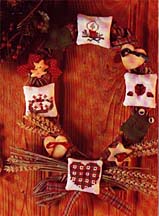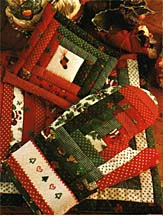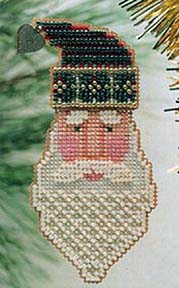 |
||||||||||
| Dyed and Gone to Heaven – An Online Magazine and Needlework Resource |
|
||||||||||||
|
 |
Christmas Needlework Traditions from Different Cultures around the World
Needlework is used to make small Christmas gifts for friends, such as Christmas cards and pillows. For children, special embroidered little shirts or sweaters with holiday motifs are made. A special needlework project customarily made for a child is "Baby's First Christmas Bib." Also executed in needlework are Christmas stockings, decorations for household linens, decor for doors and windows, and ornaments for the Christmas tree. The most common motifs depicted are Babbo Natale, candles, little red hearts and wreaths. Wreaths and embroidered stockings are often made using needlework in combination with other crafts and added embellishments, like ribbons and special printed fabrics. When religious themes are chosen, the Crib tableaux is the favorite.
 
Decorating the home with Advent wreaths and calendars are traditions in Northern Italy. The most typical Christmas tradition throughout Italy is hanging Christmas stockings under the tree. A popular ritual on Dec.24 is setting up the Nativity scene, going to Mass for Christmas Eve and preparing special foods for the Christmas Day Lunch. At 12:30 P.M. on Dec.25, no car is seen on the road throughout Italy, since everybody is sitting at the table. A revolution could easily be done and nobody would notice it!
Stitched examples provided by Elisa Tongiani, Giulia Manfredini
and Lara Seppia. Information on Christmas traditions provided
by Giulia Manfredini, M.D., Via Palestro 16, 54100 Massa, Italy

Christmas decorations done with needlework in the UK consist mainly of stitched tree ornaments, Christmas stockings, Christmas cards and, more recently, a growing interest in household linens. The most popular motifs stitched are Santas, Christmas trees, candles and snowmen. Of religious themes found, scenes of Mary and Joseph with a donkey riding into Bethlehem and the stable tableaux prevail. Cross-stitch is by far the most common technique used, with Christmas cards being the top choice of items to make. Designs from Lavender & Lace, such as Celtic Christmas and Spirit of Christmas, are very popular. The ubiquitous Christmas cards and tree decorations are the items which most often will integrate other techniques or crafts with needlework. Mill Hill beaded tree ornament kits are popular and cards are made using fabric and Fus-o-Bond which is a quick and easy option. Advent calenders are common and on Christmas Eve when children go to bed they leave a glass of sherry and a mince pie for Santa and maybe a carrot or two for the Reindeer. Mince pies, Christmas pudding, (a rich fruit mix that is boiled) and 'Yule' log (a chocolate cake roll decorated to look like a log of wood) are traditional Christmas "fayre." Christmas Eve, Christmas Day and Boxing Day are the celebrated occasions. Boxing Day is the day after Christmas Day when, in days gone by, the local trades people (e.g. baker, butcher, milkman, postman) called round for their "Christmas Box" - actually an envelope containing a tip for services rendered to the house over the past year."
Information and stitched examples provided by Rosemary
and David Sharman of
Among the Christmas customs most diligently kept are the foods prepared. One such is a rice porridge, Risengrynsgrot, and plenty is cooked to share with the Julenissen. Juleol, a holiday beer might be brewed and seven kinds of cookies, Sandbakkels, and a Julekake, a special holiday cake, baked. The traditional Christmas dinner is usually eaten after church services on Christmas Day. A typical spread would include a large pork roast or fresh ham. Another staple is lutefisk, sun-dried, lime-cured ling, a relative of the cod, traditionally served with a white sauce, potatoes and peas.
Needlework examples courtesy of Thuve-Stua and Vicki McEntaffer of Kunsten Needle Art. The composite photo shows 3 table linen designs, Holly, Caroline and Emma, available as kits from Kunsten Needle Art. Information on Christmas traditions in Norway furnished by Vicki McEntaffer and The Sons of Norway publication, Viking, Issues Dec. 1998 and Nov. 1999. For more information on Thuve-Stua designs, see their Gallery
feature on our Hardanger-themed website at http://www.caron-net.com/apr99files/apr99gal.html COPYRIGHT NOTICE: No part of this feature story nor the included designs can be reproduced or distributed in any form (including electronic) or used as a teaching tool without the prior written permission of the CARON Collection Ltd. or the featured designers. |